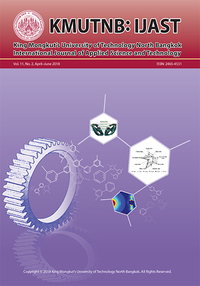Product Design Review in a Virtual Reality Environment
Main Article Content
Abstract
The aim of this research is the product design review in a virtual reality environment. The design activities consist of the usage or not of the haptic arm force-feedback combined or not with 3D stereoscopic display through basic sensors. The movements of design activities were evaluated by the low basic sensors application consisting of docking, duration, and instability sensor. The use case was thus organized around a barrel cam mechanism design which it has a single rotation motion but a complex cam 3D trajectory. We are specifically concerned by activities involved at design stage or at manufacturing preparation stage and we will have tuning design parameters to ensure that the mechanism is working well. We have implemented the experiment on four environments including either stereoscopy or haptic force-feedback device were used to establish comparisons respect to this research.
Article Details
References
[2] D. Weidlich, L. Cser, T. Polzin, D. Cristiano, and H. Zickner, “Virtual reality approaches for immersive design,” International Journal on Interactive Design and Manufacturing, vol. 3, no. 2, pp. 103–108, 2009.
[3] L. Gerlitz, “Design for product and service innovation in industry 4.0 and emerging smart society,” Journal of Security and Sustainability Issues, vol. 5, no. 2, pp. 181–198, 2015.
[4] A. Ertas and J. Jones, The Engineering Design Process, 2nd ed. Hoboken: John Wiley & Sons, Inc., 1996.
[5] K. L. Narayan, Computer Aided Design and Manufacturing. New Delhi, India: PHI Learning Pvt. Ltd., 2009.
[6] J. Giacomin, “What is human centered design,” The Design Journal, vol. 17, no. 4, pp. 606–623, 2014.
[7] K. K. Vyas, A. Pareek, and S. Vyas, “Gesture recognition and control,” International Journal on Recent and Innovation Trends in Computing and Communication, vol. 1, no. 7, pp. 575–581, 2013.
[8] E. S. A. Nasr, A. M. El-Tamimi, M. H. Abidi, and A. M. Al-Ahmari, “Virtual assembly in a semi-immersive environment,” Journal of Mechanical, Aerospace, Industrial, Mechatronic and Manufacturing Engineering, vol. 7, no. 2, pp. 223–232, 2013.
[9] A. M. Al-Ahmari, M. H. Abidi, A. Ahmad, and S. Darmoul, “Development of a virtual manufacturing assembly simulation system,” Advances in Mechanical Engineering, vol. 8, no. 3, pp. 1–13, 2016.
[10] A. Vetro, S. Yea, and A. Smolic, “Towards a 3D video format for auto-stereoscopic displays,” in Proceedings SPIE Conference on Applications of Digital Image Processing XXXI, 2008.
[11] W. M. B. Tiest and A. M. L. Kappers, “Cues for haptic perception of compliance,” IEEE Transactions on Haptics, vol. 2, no. 4, pp. 189–199, 2009.
[12] H. Bellini, W. Chen, M. Sugiyama, M. Shin, S. Alam, and D. Takayama, “Virtual & Augmented Reality: Understanding the race for the next computing platform,” Goldman Sachs, New York, USA, 2016.
[13] D. Pagliari and L. Pinto, “Calibration of Kinect for Xbox one and comparison between the two generations of microsoft sensors,” Sensors, vol. 15, no. 11, pp. 27569–27589, 2015.
[14] I. Tarnanas, A. Tsolakis, and M. Tsolaki, “Assessing virtual reality environments as cognitive stimulation method for patients with MCI,” Technologies of Inclusive Well-Being, vol. 536, pp. 39–74, 2014.
[15] A. Wilson, “Machines, Power and the ancient economy,” The Journal of Roman Studies, vol. 92, no. 16, pp. 1–32, 2002.
[16] G. Ifrah, The Universal History of Computing: From the Abacus to the Quantum Computer, Hoboken: John Wiley & Sons, Inc., 2001, pp. 171.
[17] H. Al-Mubaid, E. S. A. Nasr, and A. K. Kamrani, “Using data mining the manufacturing systems for CAD model analysis and classification,” International Journal of Agile Systems and Management, vol. 3, no. 1–2, pp. 147–162, 2008.
[18] B. Pitz, B. Fitzgerald, M. Lipacis, J. Streppa, S. Dorsey, and T. O’Shea, “Interactive Entertainment PlayStation VR and an Update from the Game Developers Conference,” Jefferies US Interactive Entertainment, New York, USA, 2016.
[19] B. N. S. Tejaswini and B. A. Srinivas, “Augmented reality-An exciting experience of real world in future,” International Journal of Combined Research & Development, vol. 3, no. 1, pp. 15–20, 2014.
[20] K. L. Narayan, Computer Aided Design and Manufacturing. New Delhi: Prentice Hall of India, 2008.
[21] A. Kour, “A survey on virtual world,” International Journal of Scientific and Research Publications, vol. 5, no. 4, pp. 1–8, 2015.
[22] G. Badillo and L. Hugo, “A new methodology to evaluate the performance of physics simulation engines in haptic virtual assembly,” Assembly Automation, vol. 34, no. 2, pp. 128–140, 2014.
[23] D. Weidlich, L. Cser, T. Polzin, D. Cristiano, and H. Zickner, “Virtual reality approaches for immersive design,” International Journal on Interactive Design and Manufacturing, vol. 3, no. 2, pp. 103–108, 2009.
[24] J. Novák-Marcinčin, “Application of the virtual reality modeling language in automated technological workplaces design,” Engineering Review, vol. 27, no. 1, pp. 1–6, 2007.
[25] G. Gonzalez-Badillo, “A new methodology to evaluate the performance of physicphysic simulation engines in haptic virtual assembly,” Assembly Automation, vol. 34, no. 2, pp. 128–140, 2014.
[26] B. Parhizkar, K. A/P Sandrasekaran, and A. H. Lashkari, “Motion detection real time 3D walkthrough in Limkokwing University of Creative Technology (Modet-Walk) using Kinect Xbox,” International Journal of Computer Science Issues, vol. 9, no 2, pp. 100–108, 2012.
[27] G. Gonzalez-Badillo, H. I. Medellin-Castillo, and T. Lim, “Development of a haptic virtual reality system for assembly planning and evaluation,” Procedia Technology, vol. 7, pp. 265–272, 2013.


